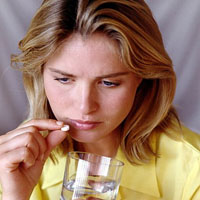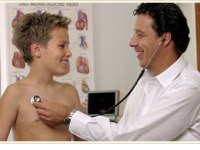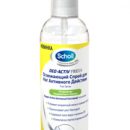What is demodecosis? How demodicosis is treated? Answers to these questions you will find in the article.
Content
What is demodecosis
Demodecosis - common pathology in humans and
Animals caused by ticks of the genus Demodex. Currently out of 65 species
and several subspecies of demodex in humans are found only two:
Demodex Follikulorum and Demodex Breis. Each view and subspecies of demodex
strictly specific for its owner.
Demodecosis,
affecting animals makes it takes appropriate measures in
agriculture, since the defeat not only the skin is connected with it and
Skins, but also internal organs of animals.

Mite
Zheleneck (Demodex Follikulorum) meets most often,
It is found only in a person in hair follicles, sebaceous
glands, out of the owner his reproduction stops. Mite
viable and outside the owner with constant humidity and room
Temperature in the dark up to 9 days. Optimal temperature for development
Tick - 30-40°C, at a temperature of 14°With ticks are in a state
Catching, and at 52°With quickly dying. In the water insects are saved to
25 days, in dry air die after 1.5 days. The most favorable
Nutrient medium for demodex - vegetable oil, fat, vaseline.
Pincers
They have dimensions of 0.3-0.4 mm. In the cavity of the hair follicle females
lay eggs, from which after 60 hours the larva hatred, which
still and constantly feeds. After 40 hours, the larva turns into
Nymph 1, which is also larger and remains in the follicle. After 72ch.
There is a conversion in nimph 2, movable, moving by skin
Call, and after 60 hours - transformation into an adult. Adult Path
re-enters the follicle and after laying eggs die. Vital
The cycle of the tick is about 15 days.
If
The owner's body has any pathological processes:
Neuroendocrine, gastrointestinal, mental, immune and
The presence of chronic infection foci occurs the body sensitization
To the bow. In this situation, Demodex is a chemical,
Mechanical stimulus promoting development and maintenance
pathological process. In addition, symbiosis is disturbed with
Corinbacteria and a conditioned pathogenic flora, which is also
launcher for the development of the disease. Perhaps also
Asymptomatic tick carriage in the absence of leather pathology. At
89% of the carriage of the parasite were discovered in the mass examination
regardless of skin pathology. The greatest activity of demodex on the skin
man is observed in the spring-autumn period, which is associated with elevated
insolation, changing the environment of the environment, immune and
Endocrine changes. Most often, the tick is found in the area
nose-lump fold, cheeks, nose, chin, rare enough - in
Neck area and very rare - in the field of back and chest.
Clinical
Manifestation of demodicosis is diverse. Exist skin and eye
Manifestations of the disease. It is necessary to distinguish directly demodecosis
and diseases, the flow of which exacerbates the presence of ticks.
How demodicosis is treated
For
Therapy selection is a clinical picture of the disease, the presence of
forms of ticks, their number. It is also necessary to take into account the concomitant
Patient pathology. For exposure directly on demodex ticks
Applied acaricidal agents to which derivatives
nitroimidazole group. The most efficient means is
Trichopol used from 4 to 6 weeks. Also used
Ornidazole cycles from 8 to 10 days. Noted not only
antiparasitic effect of the drug, but also bacteriostatic,
Incoming neutrophil activity, stimulating adrenergic
Structures, strengthening reparative processes. Perhaps application
Preparations of sulfur, angioprotectors, antiserotonin and antihistamine
Tools (Loratadina, Ebastina, Terfenadin and DR.), chlorohina, enzymes
Gastrointestinal tract, Isotretinina, Retinol Palmptat,
Calcium derivatives, sedatives, immunomodulators,
biologically active substances and other.
Outdoor
Therapy includes vesseloring (aqueous adrenaline-resorcin
Solution and other.), Mazi, containing antibiotics, Mupirocin (baccake),
Erythromycinic, Fusidinovaya, Tetracyclined Ointment, Antihistamines
Means, steroids, nonsteroidal anti-inflammatory
(indomethacinic, butadion, orthophenous ointments, etc.), drugs,
containing sulfur, naphthalan, metronidazole, 20% benzylbenzoate solution,
Vitamin A derivatives (Retinino Ointment, Retin A, Ayrol,
Benzoyl peroxide (Oxy-5, Oxy-10) and others. For therapy of near-therapy
The areas are used alcoholoic mixtures, 3-5% trichopol cream,
Sulfapyridazin sodium and others.
Effective
Preparation of sprugal containing a solution of ESDEPALETRINA and PEPERONIL
Butoxida. During demodecosis and pink eels, sprigal rubbed into the affected
Skin areas with a tampon 1-3 times a day. Clinical improvement
and recovery can be achieved in 70-87% of cases. Sprugal good
transferred and does not cause serious side effects.
Prevention
The disease is to comply with the general general rules in everyday life and
in public places. Need proper and adequate skin care,
Full food, compliance with recreation. With insignificant
Changes in the skin of the skin of the face and the periorubital region
need timely appeal to a dermatologist.









